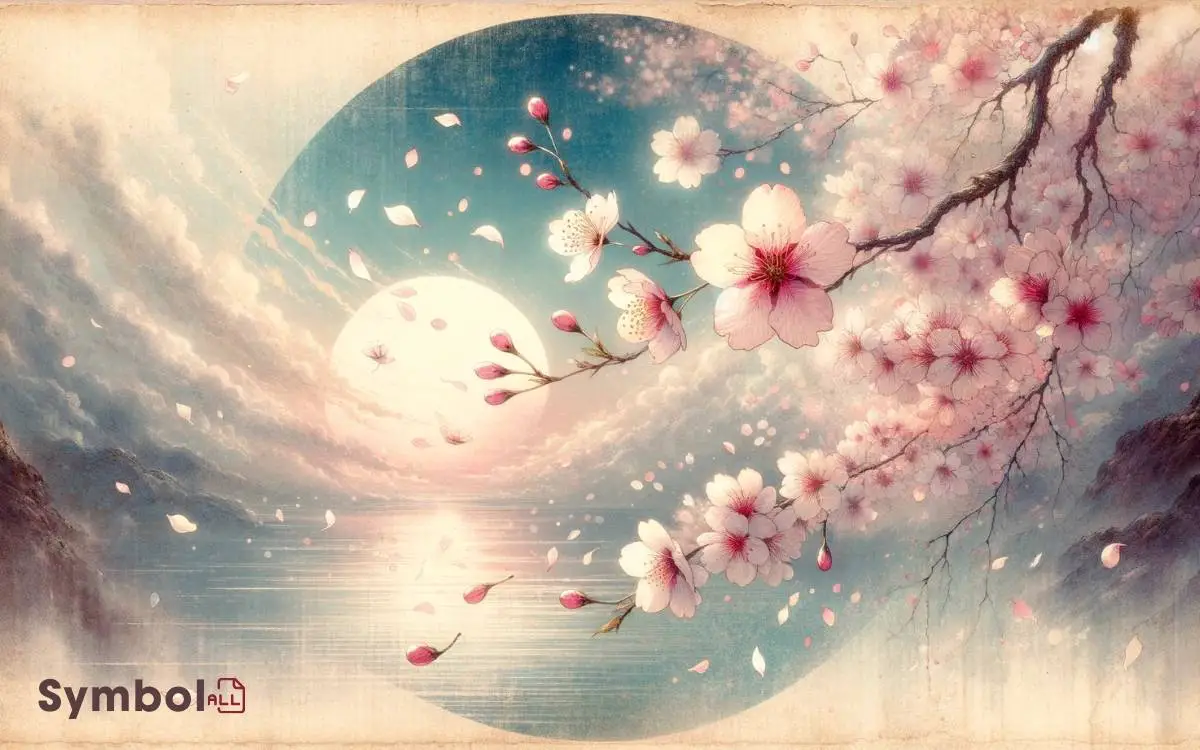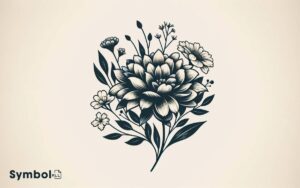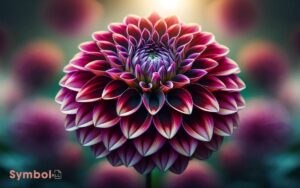What Does the Sakura Flower Symbolize? Renewal and Hope?
The Sakura flower symbolizes the delicate balance of life, death, and renewal. You’ll find it embodies life’s fleeting beauty, urging you to savor each moment before it fades. It’s a reminder that beauty and life are transient, blooming intensely yet briefly each spring.
This cycle of birth, growth, and decay represents not only the cycle of life but also the importance of mindfulness in the present.
In love, it signifies enduring bonds and the blossoming of new relationships. Its ephemeral nature also offers solace in mourning, embodying remembrance and hope.
By exploring the Sakura’s symbolism further, you’ll uncover deeper insights into life’s transient beauty and the cycle of renewal.

Key Takeaway
The Cycle of Life
Symbolizing the transient nature of life, the Sakura flower embodies the poignant beauty found in the cycle of birth, growth, and eventual decay.
You must understand that this emblematic flora doesn’t merely represent fleeting moments. Instead, it encapsulates the entirety of existence from the nascent bud to the full bloom, and ultimately, to its gentle fall from the branch.
This cyclical process mirrors human experiences, where beginnings are celebrated, growth is acknowledged, and endings, though inevitable, are honored.
The Sakura, in its silent, ephemeral grace, teaches you to appreciate the now, underscoring the importance of presence in the fleeting moments.
It’s a nuanced reminder that life, while temporary, is rich with significance, urging you to savor each phase with equal reverence and mindfulness.
Impermanence and Beauty
The ephemeral nature of the Sakura flower serves as a profound metaphor for the intertwined relationship between impermanence and beauty, compelling you to reflect on how fleeting moments often harbor the deepest aesthetic and existential significance.
| Aspect | Description | Symbolism |
|---|---|---|
| Blossoming | Sakura blooms intensely but briefly. | Life’s transient beauty |
| Petal Fall | Sakura petals fall gracefully after peaking. | The inevitable passage of time |
| Seasonal Cycle | Sakura flowers annually, marking spring. | Nature’s cycle of life and death |
| Cultural Impact | Celebrations and art inspired by Sakura bloom. | Appreciation of momentary beauty |
Renewal and Optimism
Amidst the cycle of blooming and fading, Sakura flowers embody not only the transient nature of beauty but also herald the rejuvenation and hope that each new spring brings.
This cyclical event, deeply ingrained in cultural practices, serves as a potent reminder of life’s capacity for renewal.
As Sakura trees burst into color after a barren winter, they symbolize an awakening, both of the earth and the human spirit.
This period of renewal encourages a reflective optimism, urging you to envision a future filled with possibilities.
In this context, the Sakura’s fleeting beauty isn’t a mere echo of the past but a beacon for the future, inspiring a belief in new beginnings and the resilience required to embrace them.
Love and Affection
As you explore the symbolism of the Sakura flower, you’ll find that love and affection are deeply rooted in its representation.
The notion of an eternal bond significance underscores the flower’s embodiment of enduring love, highlighting relationships that withstand the test of time.
Additionally, the emergence of springtime romance blossoms alongside the Sakura, symbolizing the flourishing of new love and the rekindling of passion in existing relationships.
Eternal Bond Significance
In exploring the significance of the sakura flower, it’s crucial to acknowledge its embodiment of eternal bonds of love and affection, deeply rooted in cultural narratives and symbolism.
This profound connection transcends mere physical beauty, delving into the essence of human relationships and their perpetual nature.
The sakura’s fleeting lifespan symbolizes the preciousness and fragility of life, urging one to cherish every moment.
- Perpetuity of Bonds: The sakura epitomizes enduring relationships that withstand the test of time.
- Cultural Resonance: It’s a potent symbol in literature and art, representing unwavering love across generations.
- Emotional Depth: Its beauty evokes deep emotional responses, reinforcing the strength of connection between loved ones.
Analyzing the sakura’s role in symbolizing eternal bonds offers a nuanced understanding of its cultural and emotional significance.
Springtime Romance Blossoms
Springtime ushers in the blossoming of sakura flowers, symbolizing a period ripe with love and affection, deeply intertwined with the themes of renewal and beginnings.
Within this framework, the sakura flower transcends mere botanical significance to embody the essence of burgeoning romance.
As you observe these petals unfurl, it’s imperative to recognize the cultural depth they hold inside Japanese society and beyond.
This phase of floral display isn’t just a natural occurrence; it represents the flourishing of relationships, mirroring the blossoms’ own journey towards full bloom.
The ephemeral nature of sakura, then, becomes a poignant metaphor for the fleeting moments of young love, encouraging one to cherish the present. Analyzing this symbol, you’ll find it’s a powerful reminder of love’s transient, yet eternal, beauty.
Mourning and Remembrance
You’ll find that the Sakura flower embodies more than ephemeral beauty; it’s a profound symbol for mourning and remembrance.
Its fleeting bloom serves as a poignant reminder of life’s transience, which, in many cultures, aids in the expression of grief and the commemoration of historical events.
This contextual significance transforms the Sakura from a mere floral spectacle into a vessel for collective memory and personal solace.
Symbolic Grief Expression
Reflecting on the ephemeral beauty of the sakura flower leads to a deeper understanding of its role in symbolizing grief expression, serving as a poignant reminder of mourning and remembrance.
The fleeting nature of sakura blooms mirrors the transient aspect of life, emphasizing the importance of cherishing moments and memories.
In this perspective, the sakura flower becomes more than a symbol of spring; it transforms into a vessel for expressing sorrow and commemorating loved ones.
- Transience: Emphasizes life’s fleeting moments, encouraging reflection and appreciation.
- Purity: Represents innocence and peace, offering comfort in times of grief.
- Renewal: Symbolizes hope and the cycle of life, reminding us that from loss comes new beginnings.
Analyzing the sakura from this viewpoint reveals its profound capacity to bridge the gap between the ephemeral and the eternal, offering solace in the face of loss.
Historical Commemoration Significance
Throughout history, the sakura flower has held a profound significance in mourning and remembrance rituals, serving as a poignant symbol of life’s impermanence and the cycle of renewal.
You’ll find that in various cultures, especially within Japan, these blossoms embody the transient nature of existence, reminding us of the fleeting moments of beauty and the inevitable march towards death.
This perspective has deeply influenced commemorative practices, where the falling petals represent souls departing the earthly domain.
During memorial ceremonies, the sakura’s delicate beauty contrasts with its ephemeral life span, offering a metaphor for human mortality.
It’s this unique blend of beauty and transience that imbues the sakura with its historical role in mourning and remembrance, encouraging reflection on the fragility and preciousness of life.
National Pride of Japan
In Japan, the sakura flower stands as a symbol of national pride, deeply woven into the cultural and historical fabric of the nation.
Beyond its breathtaking beauty, the sakura embodies resilience, renewal, and the ephemeral nature of life, themes that resonate deeply within the Japanese psyche.
- Resilience: The sakura’s ability to blossom brilliantly, even after harsh winters, mirrors the nation’s spirit of perseverance through adversity.
- Renewal: Each spring, the sakura ushers in a period of renewal and optimism, reflecting Japan’s continual quest for progress while honoring its past.
- Ephemeral Nature: The fleeting beauty of the sakura reminds citizens of the preciousness of life, encouraging mindfulness and living in the moment.
This profound connection elevates the sakura beyond mere floral beauty, making it a revered symbol of Japan’s identity and collective consciousness.
Spiritual and Philosophical Insights
Delving into the spiritual and philosophical dimensions, the sakura flower offers profound insights into the interplay between beauty, temporality, and the essence of being.
It’s a symbol that encourages you to contemplate the fleeting nature of existence, suggesting that life’s transient beauty enhances its value and meaning.
The sakura’s brief bloom serves as a poignant reminder of impermanence, a core concept in Buddhist philosophy, which emphasizes the importance of mindfulness and the acceptance of life’s ephemeral nature.
This perspective invites you to appreciate the present moment, recognizing that beauty and life itself are fleeting.
As you reflect on the sakura, you’re invited to embrace the cycles of life and death, finding peace and wisdom in the temporary, thereby cultivating a deeper appreciation for every moment.
Conclusion
To sum up, the Sakura flower encapsulates a profound spectrum of human emotions and philosophical reflections.
Emblematic of life’s ephemeral beauty and the relentless march of time, these blossoms serve as a poignant reminder of impermanence.
With over 200 varieties in Japan alone, Sakura’s symbolic resonance extends beyond mere aesthetics, embodying renewal, love, and national pride.
This diversity not only enriches the cultural tapestry but also deepens our understanding of the human condition through its spiritual and philosophical connotations.






